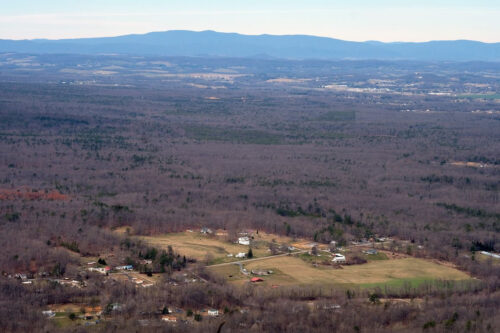By: Kathryn Miles, Politico
March 3, 2020
When is a hiking trail not the same as the land it sits on?
That’s a question before the Supreme Court, which last week heard oral arguments concerning the siting of the Atlantic Coast Pipeline, a $5.1 billion project that, if completed, would transport over a billion cubic feet of gas each day from West Virginia to North Carolina. The arguments were the latest in five years of legal snags for the project that has pitted two federal agencies against each other in a battle over jurisdiction and administrative oversight of federal lands.
As proposed, the 3-foot diameter Atlantic Coast Pipeline, co-owned by Dominion and Duke Energies, would span approximately 600 miles, 21 miles of which would cross the Monongahela and George Washington National Forests. This route would also require the pipeline to cross the 2,100-mile Appalachian National Scenic Trail, which bisects much of the George Washington Forest. Under the proposal approved by the U.S. Forest Service, the pipeline would cross the trail by way of a half-mile-long tunnel 600 feet below the trail.
Oral arguments on February 24 asked the court whether the Forest Service had the authority to grant this right-of-way access for the pipeline. At issue is the federal Mineral Leasing Act. Passed by Congress in 1920 as a response to the Teapot Dome scandal, the Mineral Leasing Act was intended to protect federal lands from private interests and to ensure fair use of the natural resources those lands contain. The act also stipulates that lands administered by the National Park Service are exempt from uses such as mineral exploration, drilling and the locating of pipelines.
Environmental groups fear that a ruling in favor of the energy companies behind the project could ultimately open up millions of acres of federal land—national monuments and historic places, wild and scenic rivers and other wilderness areas—to uses ranging from energy exploration and timber harvesting to highway construction and mining. Doing so, they say, would upend over a century of what was once considered inviolable protection.
The Appalachian Trail is administered by the National Park Service. Sixty percent of the trail that stretches from Georgia to Maine crosses state and private land, mostly by way of easement agreements. In many cases, those easements allow for shared uses, including the siting of pipelines (there are currently approximately 50 pipelines that cross the Appalachian Trail). But the remaining 40 percent of the trail is on federal land—like the national forests. And where those sections of the trail are concerned, the Mineral Leasing Act is clear, says Vermont School of Law professor Hillary Hoffmann.
“By design, the Appalachian Trail—like all National Park Service land—is granted the most protected status for federal lands,” Hoffmann says. “It’s hard to see this case as anything other than one federal agency trying to steamroll another one.”
That was the decision of the 4th Circuit Court of Appeals, which heard the case in December 2018. It determined that the Appalachian National Scenic Trail was clearly a unit of the Park Service and therefore excluded from natural resource considerations afforded to other federal lands such as national forests. Any other interpretation, “would give the Forest Service more authority than the NPS on National Park [Service] land,” insisted the panel of three judges. Doing so, they concluded, “defies logic.”
But some of the Supreme Court justices weren’t so sure. They questioned whether the Forest Service land might also be considered a kind of easement. And they entertained the petitioner’s question of what constitutes land at all: whether it is just the footpath itself, or merely the idea of the footpath, or the footpath and all of the land below it, down to the center of the earth.
“When I think of a trail, I think of something that is on top of the earth. And when I think of a pipeline that is 600 feet below the surface, that doesn’t seem like a trail,” Justice Samuel Alito said. “So instead of having to draw this distinction between the trail and the land, why can’t we just say that the trail is on the surface and something that happens 600 feet below the surface is not on the trail?”
The answer to that question matters quite a lot, Hoffmann says. “What this ultimately does is open up the idea that subsurface areas can be considered mineral estate.”
This, she says, would reclassify protected federal lands in a way similar to private property in states like Texas and Oklahoma, where property ownership often does not include access to minerals found below the ground. There, a resident might own a home, but access to the oil or natural gas below it could belong to an energy company or private investor who, in turn, also maintains the ability to mine or drill for those minerals at will.
Were the court to decide in favor of the Forest Service, Hoffmann adds, the Supreme Court would be allowing the federal government to remove the protective legal framework limiting extractive uses of parks and wilderness. These areas, she says, could then be considered fair game for the kind of “multi-use” scenarios like timber harvesting and mining seen today on land administered by the Bureau of Land Management or the Forest Service. That, in turn, would allow the BLM and USFS to grant drilling and pipeline rights to dozens—if not hundreds—of similarly protected National Park Service parcels, including previously protected places like Minnesota’s Boundary Waters, the already reduced Bears Ears National Monument in Utah, or national parks, like Grand Teton, that are abutted on multiple sides by Forest Service land.
“Imagine bridges, pipelines, or water projects bisecting the Grand Canyon, its walls, or the Colorado River,” Hoffmann says. “It’s almost as if we’ve forgotten that public lands belong to the entire public, and not just to the Department of Agriculture and whomever happens to be secretary at the time,” Hoffmann says.
The Mineral Leasing Act, she says, is supposed to prevent that from happening. And that has left Hoffmann and other legal scholars—including at least one of the Supreme Court justices—wondering why the court agreed to hear the case at all.
Just moments into the oral arguments, Justice Ruth Bader Ginsburg questioned whether the entire argument might not be moot when it comes to the completion of Atlantic Coast Pipeline. She noted that the 4th Circuit Court of Appeals vacated the Forest Service’s approval of the project based not just on the problematic Appalachian Trail crossing, but also on multiple environmental and procedural missteps along the way.
This question was not an integral part of last week’s arguments, but environmental law scholars say it should have been.
Unlike national parks, which are preserved as “unimpaired” resources, national forests have always been managed with multiple uses in mind, including timber harvesting and mineral exploration. However, these uses are restricted by multiple federal laws, including the National Forest Management Act, which mandates that forests be governed by conservation plans that promote ecological diversity and health, and the National Environmental Policy Act, which requires all federal agencies to prepare a formal environmental impact statement prior to altering the land those agencies manage for any so-called special use (such as routing a pipeline through the forest). This impact statement must demonstrate that any special use will not harm any sensitive species found within the forest.
When Dominion Energy first announced plans for the pipeline in 2015, the Federal Energy Regulatory Commission required the company to complete an environmental impact statement that included a full account of possible water issues, along with an understanding of potential damage to threatened and endangered species, such as the candy darter—a rainbow colored fish recently added to the endangered species list. Because the pipeline would cross through mountainous and unstable terrain, the Forest Service also required Atlantic to produce proof of concept designs demonstrating the stability and safety of its pipeline in 10 high hazard areas along the proposed corridor.
Atlantic eventually produced two designs for demonstration purposes only. The Forest Service found both suspect and renewed its request for 10 actual site designs. The Forest Service also rejected stability studies provided by Atlantic after noting they had not been conducted by properly certified professionals. Although Atlantic did not submit its requisite environmental impact study, initial reports submitted by Dominion acknowledged construction of the pipeline would most likely “displace certain sensitive species.” Simultaneous internal analysis at the Forest Service both corroborated and strengthened this conclusion and determined that construction of the pipeline would have long-lasting negative effects not only on threatened and endangered species, but also on the ecosystem as a whole.
Forest Service policy also mandates that environmental impact studies must prove that the proposed special use “cannot reasonably be accommodated on non-National Forest Service lands.” The 4th Circuit Court of Appeals found that Atlantic did not provide the requisite analysis demonstrating that routing the pipeline through national forests was the only viable alternative. The Forest Service requested a “National Forest Avoidance Alternative” for the routing of the pipeline. The court found that Atlantic also failed to provide that document.
In January 2016, the Forest Service rejected the proposed route for the pipeline. The two regional heads responsible for making this determination—Kathleen Atkinson, regional forester for the Eastern Region, and Tony Tooke, for the Southern region, cited multiple “inconsistencies with Forest Plan direction,” particularly as they related to ecosystem restoration projects and the protection of three sensitive species: Cheat Mountain salamanders, Cow Knob salamanders and West Virginia northern flying squirrels.
Clyde Thompson was National Forest supervisor for Monongahela at the time. In a phone interview last week, he acknowledged that Atlantic’s failures to complete multiple aspects of the environmental impact and stability studies were major roadblocks to the approval of the pipeline, but he says they weren’t insurmountable.
“The Forest Service was never anti-pipeline,” Thompson says. “We were always just trying to minimize adverse impacts and ensure that worst-case scenarios had been vetted.”
That process was halted shortly after the 2016 election.
According to Thompson and others familiar with the project, in late 2016, a high-ranking Forest Service official, issued a memo informing regional forestry staff that the pipeline would be approved as prescribed by Atlantic and on that company’s timeline.
“The Forest Service changed its mind because of a change in political winds,” says Kent Karriker, who served as the ecosystems group leader for the Monongahela National Forest. “It was made very clear that we were now going to toe the line for Dominion.”
Karriker says he and others working on the impact study were told they were no longer allowed to correspond with Dominion or include their findings on the official Federal Energy Regulatory Commission docket, the document hub for the approval process.
In May 2017, the Forest Service announced Atlantic was exempt from completing the 10 stabilization designs, which would have also included requisite analysis of landslide risks and erosion mitigation. It also exempted Atlantic from National Forest avoidance route alternatives, a statutory requirement demanding that companies demonstrate the only viable path for their pipeline is through federal land, and 13 environmental standards related to water quality, endangered species and outdoor recreation. A few months later, the Forest Service reversed its findings regarding the long-term ecological impact of the pipeline.
“We were basically shut down,” says Karriker, who had authored the impact study. “The project was taken away from people at the forest level and was handled at the regional and Washington level who would go along with whatever Dominion wanted to do, up to and including changing the fact determinations I had written for several sensitive species that showed the project would impact them in a way that was not allowed by the regulations.”
Atkinson and Tooke signed the pipeline approval in November 2017. Soon after, Tooke was promoted to Forest Service chief. (He later resigned after sexual harassment allegations were made against him.) Atkinson retired last year. Neither responded to interview requests. However, in a USFS news release announcing the approval, Atkinson was quoted as saying the approval “supports Forest Service efforts to provide for multiple uses, minimize impacts to natural resources, and to implement federal polices that encourage energy infrastructure, jobs, and economic growth.”
A group of conservation organizations, led by the Cowpasture River Preservation Association and argued by the Southern Environmental Law Center, challenged this approval in the 4th Circuit of Appeals. Arguments were heard in September 2018; the judges released their unanimous findings in December of that year.
It’s not clear to what extent the circuit court was aware of the internal machinations at work in the Forest Service that led to the eventual approval of the pipeline. But the justices there were decisive in finding that the Forest Service’s multiple “reversals” and the agency’s eventual decision to approve the pipeline were both “arbitrary and capricious.” In their ruling, the judges listed myriad deficiencies and errors in the studies conducted by both Atlantic and the Forest Service. They concluded the Forest Service “abdicated its responsibility to preserve national forest resources,” calling the agency’s disregard for deleterious effects associated with the pipeline “nothing short of remarkable.”
Neither the Forest Service nor the Atlantic Coast Pipeline appealed the circuit court’s findings of violations to the National Forest Management Act or the National Environmental Policy Act. As a result, those violations will continue to halt the pipeline, regardless of how the Supreme Court decides (no doubt why Ginsburg raised the issue so early in the oral arguments).
Given the number of outstanding violations found by the 4th Circuit Court and the clear specificity of the Mineral Leasing Act, the Supreme Court could determine it erred in agreeing to hear the case at all, Georgetown University Law professor Hope Babcock says.
“It’s hard to understand how the court could find ambiguity in the plain language of the Mineral Leasing Act,” Babcock says. Should a member of the Supreme Court decide that they erred in agreeing to hear the case, now that oral arguments have been made, the justices can caucus and determine to send the case back to the circuit court—an unlikely event, given past Supreme Court practice, she says, but one that is technically possible.
Should the Supreme Court uphold the circuit court’s decision, other pipelines in development may also be in jeopardy. Of particular concern to energy watchers is the beleaguered Mountain Valley Pipeline, which was also granted access by the Forest Service to cross the Appalachian Trail over federal forest lands.
And it’s important to note that, even if the Supreme Court issues a ruling in favor of the Atlantic Coast Pipeline with regards to the Appalachian Trail crossing, Atlantic and the Forest Service will still need to rectify those permitting violations.
“The case would still be far from over for the Atlantic Coast Pipeline,” says D.J. Gerken, senior attorney for the Southern Environmental Law Center, which argued the case.
But the real issue, agrees Gerken, Hoffmann and Babcock, will be what that ruling means for the rest of the public lands administered by the National Park Service.
“We would be putting in jeopardy many of our really pristine wilderness areas, along with historical places and monuments protected by a buffer of forest,” Hoffmann says. “Basically, it would be giving the Forest Service permission to trump National Park Service management mandates. There’s no way Congress intended this to be the effect of the Mineral Leasing Act.”





